
Rhizobium is a genus of Gram-negative soil bacteria that fix nitrogen. Rhizobium species form an endosymbiotic nitrogen-fixing association with roots of (primarily) legumes and other flowering plants.

Albert Jan Kluyver ForMemRS was a Dutch microbiologist and biochemist.

The Christian Catholic Church of Switzerland is an Old Catholic denomination in Switzerland. This denomination is part of the Union of Utrecht.
The Halanaerobiales are an order of bacteria placed within the class Clostridia, and encompassing two families, the Halanaerobiaceae and the Halobacteroidaceae. Originally placed within the highly polyphyletic class Clostridia, according to the NCBI and LPSN, it is now thought to lie outside the Bacillota. Halanaerobiales are halophilic obligate anaerobes with a fermentative or homoacetogenic metabolism.
Pedomicrobium is a ubiquitous bacterium dominant in biofilms of man-made aquatic environments such as water distribution systems and bioreactors. Due to their abilities to oxidise manganese (Mn), they are found to be the main culprits of Mn related “dirty water”.
In taxonomy, Hyphomonas is a genus of the Hyphomonadaceae.
Dimethyl-sulfide monooxygenase (EC 1.14.13.131, dimethylsulfide monooxygenase) is an enzyme with systematic name dimethyl sulfide,NADH:oxygen oxidoreductase. This enzyme catalyses the following chemical reaction

Hyphomicrobium is a genus of Gram-negative, non-spore-forming, rod-shaped bacteria from the family of Hyphomicrobiaceae. It has a large polar or sub-polar filiform prostheca very similar to that of Caulobacter. In addition to having a nutritional function, the prostheca also plays a role in the initiation of DNA replication.
Hyphomicrobium aestuarii is a Gram-negative bacteria from the genus of Hyphomicrobium.
Hyphomicrobium chloromethanicum is an aerobic, methylotrophic bacteria from the genus of Hyphomicrobium which can utilize chloromethane as the only source of carbon.
Hyphomicrobium coagulans is a Gram-negative, non-spore-forming, methylotrophic bacteria from the genus of Hyphomicrobium.
Hyphomicrobium denitrificans is a bacterium from the genus of Hyphomicrobium which was isolated from the Netherlands.
Hyphomicrobium facile is a bacterium from the genus of Hyphomicrobium which was isolated from soil in New Hampshire in the United States.
Hyphomicrobium hollandicum is an aerobic bacteria from the genus of Hyphomicrobium which was isolated from soil in California in the US.
Hyphomicrobium methylovorum is a bacterium from the genus of Hyphomicrobium which was isolated from soil samples in Japan.
Hyphomicrobium nitrativorans is a bacterium from the genus of Hyphomicrobium which was isolated from biofilm at the Montreal Biodome in Canada.
Hyphomicrobium sulfonivorans is a bacterium from the genus of Hyphomicrobium which was isolated from garden soil in Warwickshire in England.
Hyphomicrobium vulgare is a bacterium from the genus of Hyphomicrobium.

Rothia is a Gram-positive, aerobic, rod-shaped and non-motile bacterial genus from the family Micrococcaceae. Rothia bacteria can cause disease in humans and immunosuppressed humans.




